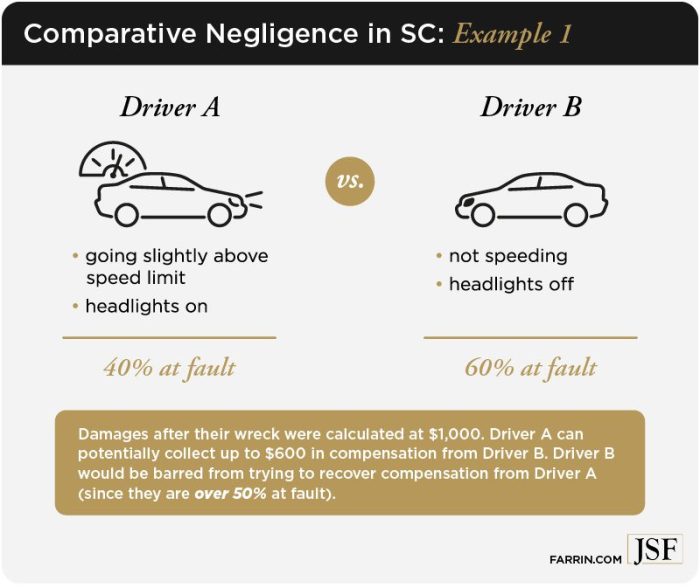Comparative Negligence in Car Accidents – Navigating the aftermath of a car accident can be a complex process, particularly when it comes to determining fault and liability. Understanding the principle of comparative negligence is crucial, as it plays a significant role in how compensation is awarded in car accident claims. This article will explain what comparative negligence is, how it affects claims, and how to navigate the complexities of fault and liability in car accidents.
What is Comparative Negligence?
Comparative negligence is a legal doctrine used to determine the degree of fault of each party involved in a car accident. Unlike the traditional contributory negligence rule, which can bar a plaintiff from recovering damages if they are found even partially at fault, comparative negligence allows for the allocation of fault among all parties involved.
In practice, this means that if you are involved in a car accident, your compensation may be reduced based on your percentage of fault. For example, if you are deemed to be 20% at fault for the accident, you would receive 80% of the total compensation awarded.
Types of Comparative Negligence
Understanding the different types of comparative negligence can help you grasp how your claim may be impacted based on your state’s laws.
Pure Comparative Negligence
In states that follow pure comparative negligence, a plaintiff can recover damages even if they are found to be 99% at fault. The total damages awarded will be reduced by the percentage of fault assigned to the plaintiff. For example, if the total damages are $100,000 and the plaintiff is found to be 70% at fault, they would recover $30,000.
States with Pure Comparative Negligence Laws include:
- California
- New York
- Florida
- Louisiana
Modified Comparative Negligence
Modified comparative negligence allows recovery only if the plaintiff’s fault is below a certain threshold, typically set at 50% or 51%. In these states, if you are found to be equally or more at fault than the other party, you cannot recover damages. For example, if you are found to be 51% at fault, you would not receive any compensation.
States with Modified Comparative Negligence Laws include:
- Texas
- Illinois
- Georgia
- Indiana
How Comparative Negligence Affects Car Accident Claims
Understanding how comparative negligence affects car accident claims is crucial for anyone involved in an accident. Here are some key points:
- Determining Fault: After an accident, insurance companies will investigate to determine fault. This involves reviewing police reports, witness statements, and any available evidence. The assigned fault percentage can significantly affect the compensation amount.
- Negotiating Settlements: In negotiations with insurance companies, understanding your degree of fault can strengthen your position. If you are found to be partially at fault, presenting evidence that minimizes your negligence can help in achieving a fair settlement.
- Impact on Lawsuits: If you decide to pursue a lawsuit, the court will also consider comparative negligence in determining the final compensation amount. Evidence and testimony will play a critical role in establishing fault percentages.
Steps to Take After a Car Accident
After a car accident, it’s crucial to take specific steps to protect your rights and ensure you receive the compensation you deserve. Here’s a breakdown of the essential steps:
Step 1: Ensure Safety and Call for Help
- Move to a safe area if possible and call 911 for assistance. Ensure that everyone involved is safe.
Step 2: Gather Evidence
- Take photos of the accident scene, vehicle damage, and any visible injuries. Collect witness information and document their statements if possible.
Step 3: Report the Accident
- Notify your insurance company about the accident as soon as possible. Provide them with all relevant information.
Step 4: Seek Medical Attention
- Regardless of the severity of your injuries, seeing a healthcare professional is essential for your health and to document any potential injuries for your claim.
Step 5: Keep Records
- Maintain detailed records of all expenses related to the accident, including medical bills, repair costs, and any other expenses incurred as a result.
Common Questions About Comparative Negligence
What if I am found to be partially at fault in an accident?
If you are found to be partially at fault, your compensation will be reduced by your percentage of fault. For instance, if your damages total $50,000 and you are found to be 20% at fault, you would receive $40,000.
How can I prove the other party’s negligence?
To prove negligence, you must demonstrate that the other party owed you a duty of care, breached that duty, and caused your damages. This often involves gathering evidence such as witness statements, police reports, and photographs of the accident scene.
Can I still recover damages if I was speeding at the time of the accident?
Yes, you can still recover damages even if you were speeding, as long as you can demonstrate that the other party was also at fault. However, your recovery may be reduced based on your degree of fault.
Conclusion
Understanding comparative negligence is essential for anyone involved in a car accident. The degree of fault assigned to each party can significantly impact the amount of compensation awarded. By familiarizing yourself with the principles of comparative negligence, the types of comparative negligence laws in your state, and the steps to take after an accident, you can navigate the complexities of fault and liability more effectively.
Being proactive, gathering evidence, and consulting with a legal professional can all contribute to achieving a fair outcome in your case. Remember, while the road to recovery after an accident can be challenging, understanding your rights can empower you to seek the compensation you deserve.




